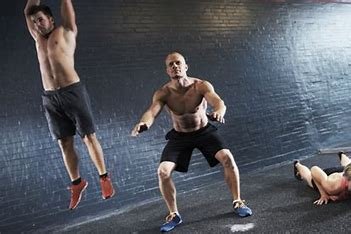Plyometric exercises are high-intensity movements that involve explosive movements to increase strength, power, and speed. They generally focus on using the stretch-shortening cycle (SSC), which is the process where a muscle is first stretched (eccentric phase) and then rapidly contracted (concentric phase). This cycle helps generate more force and speed in the muscle’s contraction. Plyometrics are widely used by athletes for improving performance in sports like running, basketball, and volleyball.

Key Characteristics of Plyometric Exercises:
- Explosive Movements: These exercises involve quick, forceful actions, such as jumping, hopping, and bounding.
- Stretch-Shortening Cycle: As mentioned, plyometric exercises make use of the rapid stretching and shortening of muscles to generate power. For example, when you land from a jump, your muscles stretch, and then they rapidly contract to propel you back up or forward.
- High-Intensity: They are intense and require proper form and adequate rest between sets to avoid injury.
Types of Plyometric Exercises:
- Jumping Movements:
- Box Jumps: Jumping onto and off a sturdy box.
- Broad Jumps: Jumping forward as far as possible.
- Tuck Jumps: Jumping straight up while pulling your knees toward your chest.
- Hopping Movements:
- Single-leg Hops: Hopping on one leg to build strength and coordination.
- Double-leg Hops: Using both legs to hop over a distance or obstacle.
- Bounding Movements:
- Lateral Bounds: Jumping side-to-side with power.
- Speed Bounds: Using alternating steps to create an explosive, bounding motion.
- Medicine Ball Throws:
- These can also be considered plyometric exercises when used explosively, like slamming a medicine ball to the ground or throwing it with power.
Benefits of Plyometric Exercises:
- Increased Power and Speed: They help athletes to become faster and more explosive, which is beneficial for various sports that require quick movements.
- Improved Coordination and Balance: The rapid movement of the muscles trains the nervous system, improving overall body coordination.
- Better Muscular Endurance: Plyometric exercises build strength and endurance, especially in the legs, which is important for runners, sprinters, and jumpers.
- Fat Loss: Due to the intensity of the exercises, they are effective in burning calories and improving cardiovascular health.
Safety and Considerations:
- Warm-up: Because plyometrics are high-intensity, a proper warm-up is essential to avoid injury. Dynamic stretching and light aerobic exercises are great ways to prepare.
- Proper Form: Technique is crucial in plyometrics to prevent stress on joints and muscles, particularly the knees and ankles.
- Progression: Start with lower-intensity exercises (like jumping jacks or squat jumps) and gradually increase the intensity to avoid overwhelming the body.
- Recovery: Give muscles adequate recovery time between sessions since plyometrics place a significant amount of stress on the muscles and joints.
